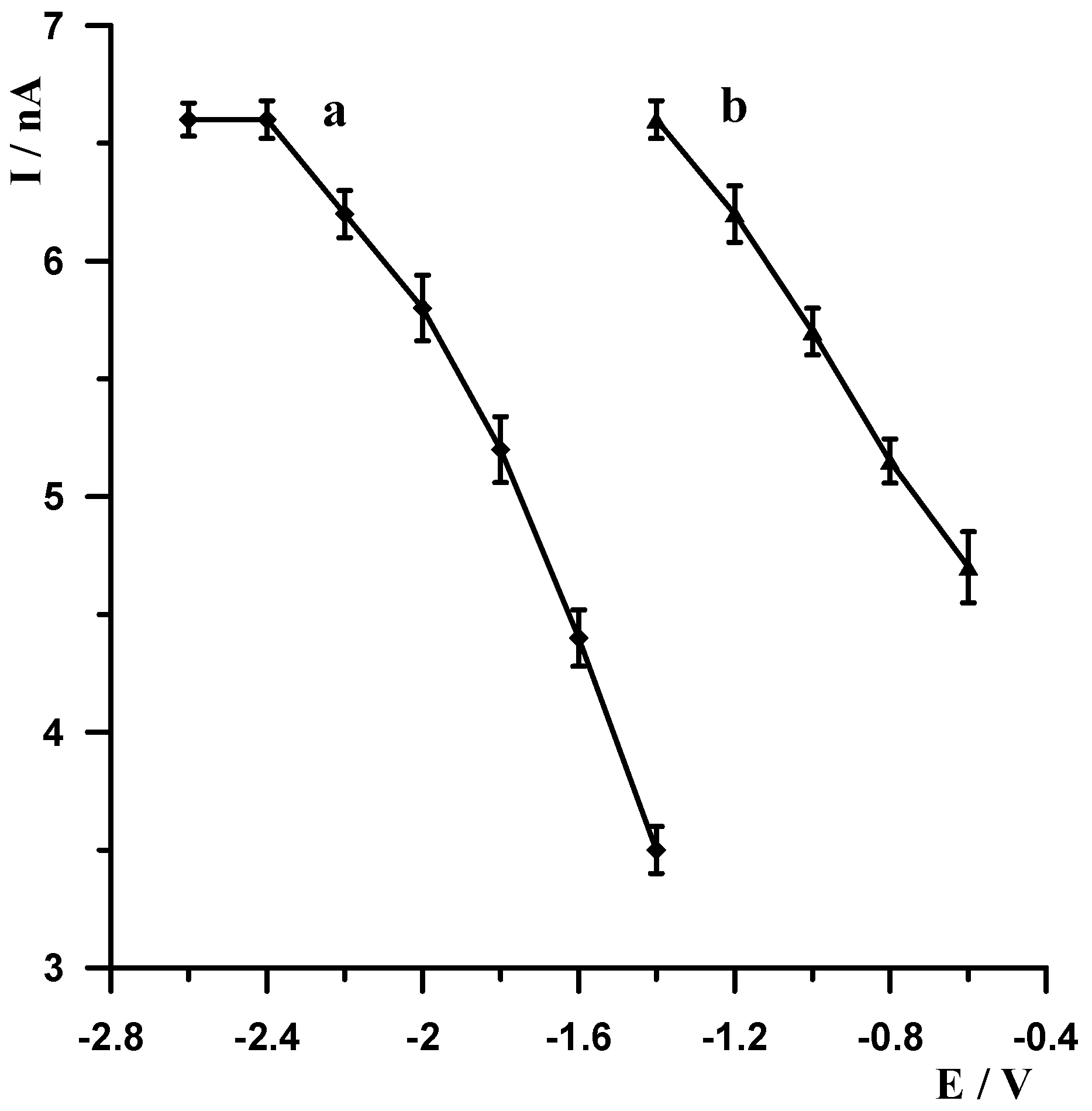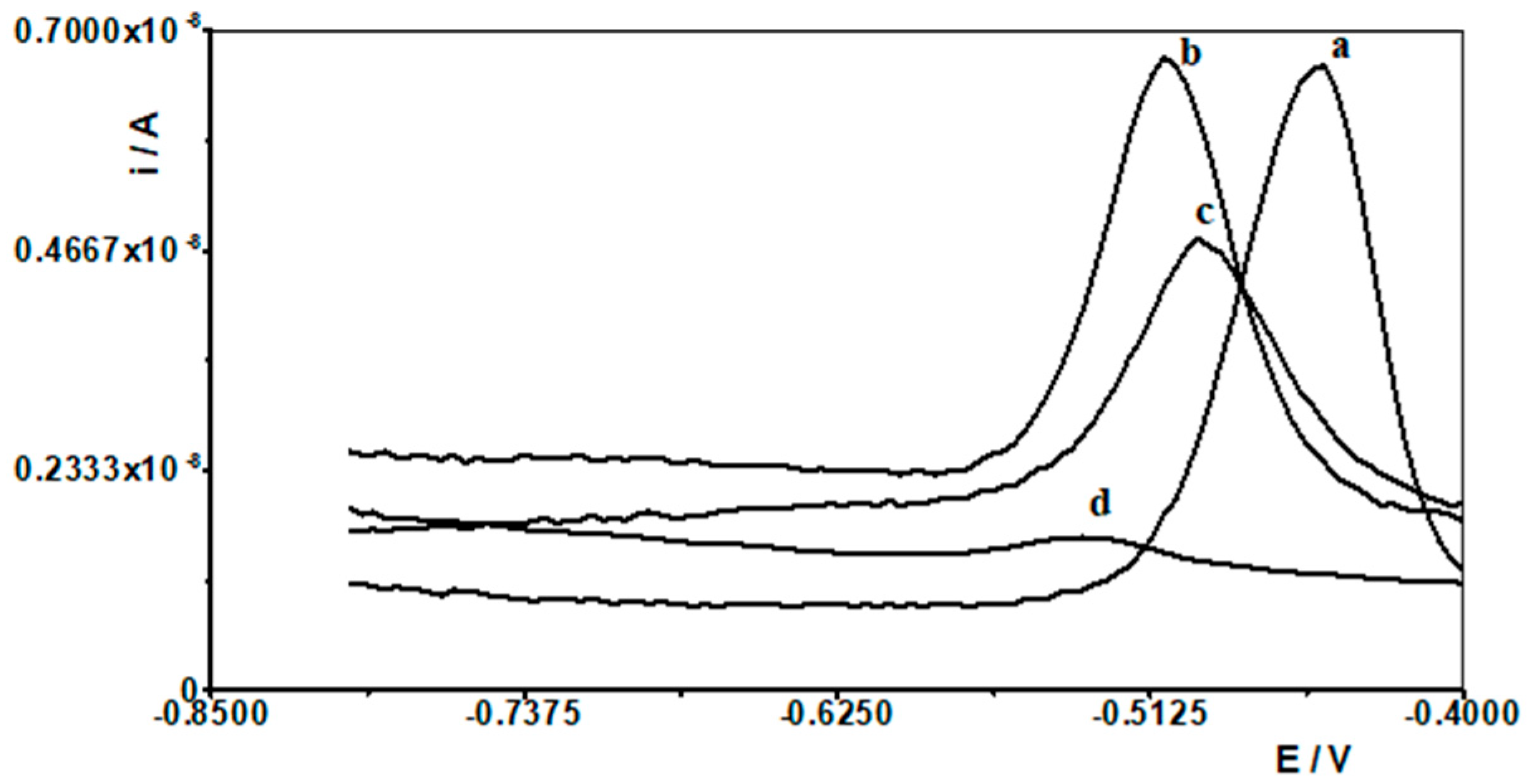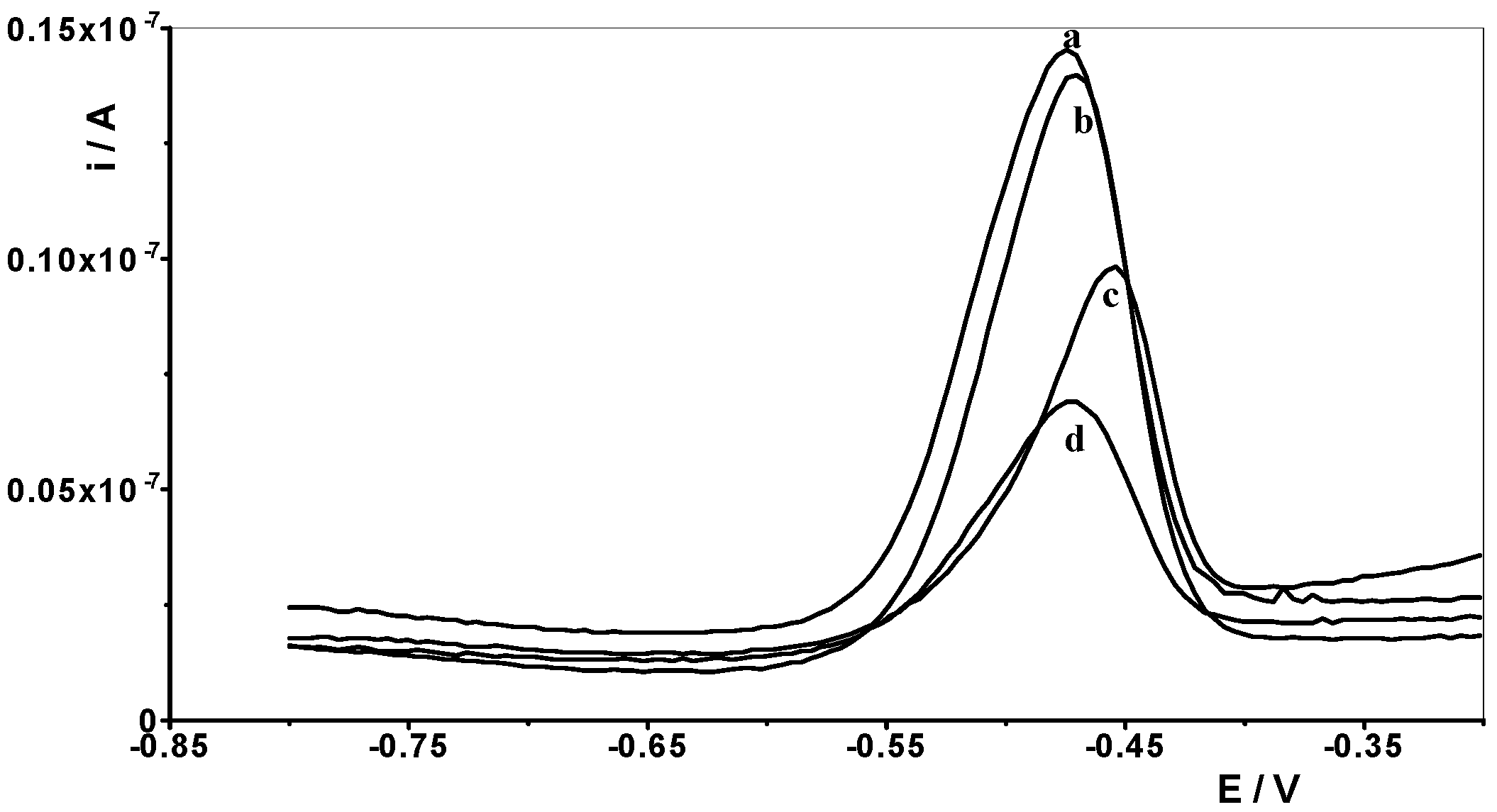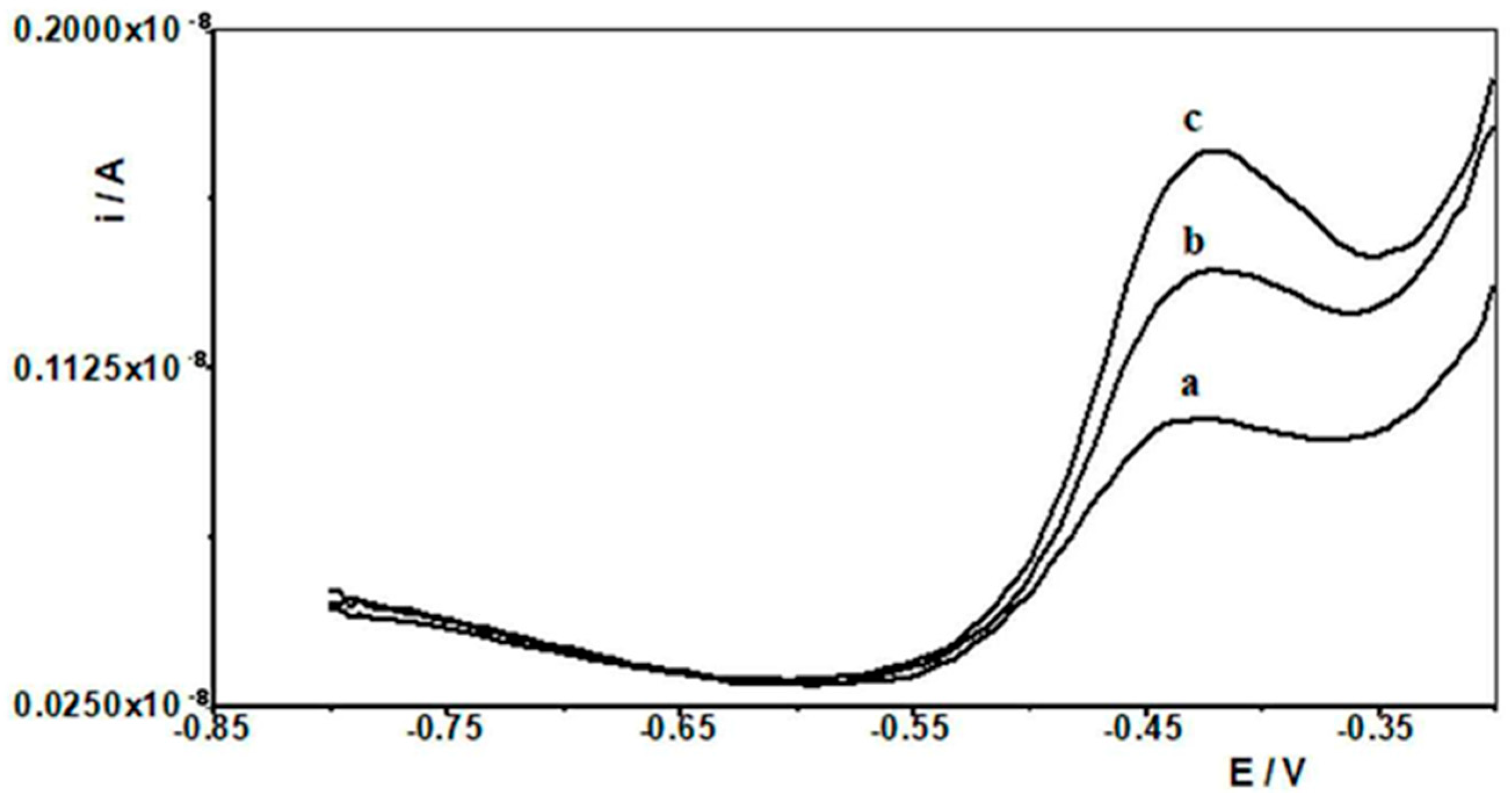A Super-Sensitive Voltammetric Procedure for the Determination of Pb(II) Ions in Natural Waters Using an Environmentally Friendly Microelectrode
Abstract
1. Introduction
2. Materials and Methods
2.1. Instrumentation Equipment
2.2. Reagents
2.3. Procedure for the DPASV Analysis
3. Results
3.1. Optimization for the Detection of Pb(II) at SBiµE
3.1.1. Composition of the Supporting Electrolyte
3.1.2. Conditions for Electrode Activation
3.1.3. Conditions for Lead Accumulation


3.2. Analytical Performance and Discussion
3.3. Repeatability, Reproducibility, and Long-Term Stability of SBiµE
3.4. The Influence of Lanthanides as Interferents
3.5. Analytical Applications
4. Conclusions
Author Contributions
Funding
Institutional Review Board Statement
Informed Consent Statement
Data Availability Statement
Conflicts of Interest
References
- Saeed, A.A.; Singh, B.; Nooredeen Abbas, M.; Dempsey, E. Evaluation of bismuth modified carbon thread electrode for simultaneous and highly sensitive Cd (II) and Pb (II) determination. Electroanalysis 2016, 28, 2205. [Google Scholar] [CrossRef]
- Ahmed, M.J.; Mamun, M.A. Spectrophotometric determination of lead in industrial, environmental, biological and soil samples using 2,5-dimercapto-1,3,4-thiadiazole. Talanta 2001, 55, 43. [Google Scholar] [CrossRef]
- Jang, A.; Seo, Y.W.; Bishop, P.L. The removal of heavy metals in urban runoff by sorption on mulch. Environ. Pollut. 2005, 133, 117. [Google Scholar] [CrossRef] [PubMed]
- Abdel-Halim, S.H.; Shehata, A.M.A.; El-Shahat, M.F. Removal of of lead ions from industrial waste water by different types of natural materials. Water Res. 2003, 37, 1678. [Google Scholar] [CrossRef]
- Mesquita, R.B.R.; Fernandes, S.M.V.; Rangel, A.O.S. A flow system for the spectrophotometric determination of lead in different types of waters using ion-exchange for pre-concentration and elimination of interferences. Talanta 2004, 62, 395. [Google Scholar] [CrossRef] [PubMed]
- Bai, H.; Zhou, Q.; Xie, G.; Xiao, J. Temperature-controlled ionic liquid–liquid-phase microextraction for the pre-concentration of lead from environmental samples prior to flame atomic absorption spectrometry. Talanta 2010, 80, 1638. [Google Scholar] [CrossRef] [PubMed]
- Zhang, X.; Xu, J.; Zhang, Z.; Li, P.; He, C.h.; Zhong, M. Pb(II) adsorption properties of three-dimensional porous bacterial cellulose/graphene oxide composite hydrogel subjected to ultrasonic treatment. Materials 2024, 17, 3053. [Google Scholar] [CrossRef] [PubMed]
- Raj, K.; Das, A.P. Lead pollution: Impact on environmental and human health and approach for a sustainable solution. J. Environ. Chem. Ecotxicol. 2023, 5, 79. [Google Scholar] [CrossRef]
- Grabarczyk, M.; Wardak, C. Rapid determination of lead in environmental water by anodic stripping voltammetry. Anal. Lett. 2016, 49, 1004. [Google Scholar] [CrossRef]
- Baś, B.; Piech, R.; Niewiara, E.; Ziemnicka, E.M.; Stobierski, L.; Kubiak, W.W. TiC working electrode. Voltammetric characteristics and application for determination of lead traces stripping voltammetry. Electroanalysis 2008, 20, 1655. [Google Scholar] [CrossRef]
- Li, G.; Ji, Z.; Wu, K. Square wave anodic stripping voltammetric determination of Pb2+ using acetylene black paste electrode based on the inducing adsorption ability of I−. Anal. Chim. Acta 2006, 577, 178. [Google Scholar] [CrossRef]
- Rodrigues, J.A.; Rodrigues, C.M.; Almeida, P.J.; Valente, I.M.; Goncalves, L.M.; Compton, R.G.; Barros, A.A. Increased sensitivity of anodic stripping voltammetry at the hanging mercury drop electrode by ultracathodic deposition. Anal. Chim. Acta 2011, 701, 152. [Google Scholar] [CrossRef]
- Grabarczyk, M. Sensitive adsorptive stripping voltammetric method for direct determination of trace concentration of lead in the presence of cupferron in natural water samples. In. J. Environ. Anal. Chem. 2013, 93, 1008. [Google Scholar] [CrossRef]
- Arancibia, V.; Nagles, E.; Cornejo, S. Determination of lead in the presence of morin-5′-sulfonic acid and sodium dodecyl sulfate by adsorptive stripping voltammetry. Talanta 2009, 80, 184. [Google Scholar] [CrossRef] [PubMed]
- Espada-Bellido, E.; Galindo-Riaño, M.D.; García-Vargas, M. Sensitive adsorptive stripping voltammetric method for determination of lead in water using multivariate analysisfor optimization. J. Hazard. Mater. 2009, 166, 1326. [Google Scholar] [CrossRef] [PubMed]
- Motshakeri, M.; Angoro, B.; Phillips, A.R.J.; Svirskis, D.; Kilmartin, P.A.; Sharma, M. Advancements in mercury-free electrochemical sensors for iron detection: A decade of progress in electrode materials and modifications. Sensors 2025, 25, 1474. [Google Scholar] [CrossRef]
- Xu, K.; Perez-Rafols, C.; Marchoud, A.; Cuartero, M.; Crespo, G.A. Anodic stripping voltammetry with the hanging mercury drop electrode for trace metal detection in soil samples. Chemosensors 2021, 9, 107. [Google Scholar] [CrossRef]
- Barek, J.; Fogg, A.G.; Muck, A.; Zima, J. Polarography and voltammetry at mercury electrodes. Crit. Rev. Anal. Chem. 2001, 31, 291. [Google Scholar] [CrossRef]
- Vyskocil, V.; Barek, J. Mercury electrodes-possibilities and limitations in environmental electroanalysis. Crit. Rev. Anal. Chem. 2009, 39, 173. [Google Scholar] [CrossRef]
- Baldo, M.A.; Daniele, S.; Mazzocchin, G.A. Cyclic voltammetry at mercury microelektrodes Effects of mercury thickness and scan rate. Electrochim. Acta 1996, 41, 811. [Google Scholar] [CrossRef]
- Zhao, Q.; Chai, Y.; Yuan, R.; Luo, J. Square wave anodic stripping voltammetry determination of lead based on the Hg(II) immobilized graphene oxide composite film as an enhanced sensing platform. Sens. Actuators B Chem. 2013, 178, 379. [Google Scholar] [CrossRef]
- Prabakar, S.J.R.; Sakthivel, C.; Narayanan, S.S. Hg(II) immobilized MWCNT graphite electrode for the anodic stripping voltammetric determination of lead and cadmium. Talanta 2011, 85, 290. [Google Scholar] [CrossRef]
- Zen, J.-M.; Chung, H.-H.; Kumar, A.S. Determination of lead(II) on a copper/mercury-plated screen-printed electrode. Anal. Chim. Acta 2000, 421, 189. [Google Scholar] [CrossRef]
- Hassan, K.H.; Gaber, S.E.; Altahan, M.F. Single and simultaneous voltammetric sensing of lead(II), cadmium(II) and zinc(II) using a bimetallic Hg-Bi supported on poly(1,2-diaminoanthraquinone)/glassy carbon modified electrode. Sens. Bio-Sens. Res. 2020, 29, 100369. [Google Scholar] [CrossRef]
- Guo, D.; Li, J.; Yuan, J.; Zhou, W.; Wang, E. Nafion film immobilized nano Ag-Hg amalgam glassy carbon electrode used for simultaneous determination of lead, cadmium and copper. Electroanalysis 2010, 22, 69. [Google Scholar] [CrossRef]
- Grabarczyk, M.; Adamczyk, M. A simple, fast and inexpensive simultaneous determination of trace bismuth(III) and lead(II) in water samples by adsorptive stripping voltammetry. J. Anal. Methods Chem. 2017, 2014, 1486497. [Google Scholar] [CrossRef] [PubMed]
- Song, W.; Zhang, L.; Shi, L.; Li, D.W.; Li, Y.; Long, Y.T. Simultaneous determination of cadmium(II), lead(II) and copper(II) by using a screen-printed electrode modified with mercury nano-droplets. Microchim. Acta 2010, 169, 321. [Google Scholar] [CrossRef]
- Sanchez-Calvo, A.; Blanco-Lopez, M.C.; Costa-Garcia, A. Paper-Based Working Electrodes Coated with Mercury or Bismuth Films for Heavy Metals Determination. Biosensors 2020, 10, 52. [Google Scholar] [CrossRef]
- Yildiz, C.; Bayraktepe, E.; Yazan, Z. Highly sensitive direct simultaneous determination of zinc(II), cadmium(II), lead(II), and copper(II) based on in-situ-bismuth and mercury thin-film plated screen-printed carbon electrode. Monatsh. Chem. 2021, 152, 1527. [Google Scholar] [CrossRef]
- Josypcuk, B.; Tvorynska, S. Screen-printed electrodes covered by mercury film or meniscus. Electrochim. Acta 2025, 513, 145565. [Google Scholar] [CrossRef]
- Silva, I.S.; Medeiros de Araujo, D.; Vocciante, M.; Ferro, S.; Martinez-Huitle, C.A.; Dos Santos, E.V. Electrochemical determination of lead using a composite sensor obtained from low-cost green materials: Graphite/cork. Appl. Sci. 2021, 11, 2355. [Google Scholar] [CrossRef]
- Grabarczyk, M.; Wawruch, A. Screen-Printed Carbon Electrode Modified with Carbon Nanotubes and Copper Film as a Simple Tool for Determination of Trace Concentrations of Lead Ions. Membranes 2024, 14, 53. [Google Scholar] [CrossRef]
- Mojica, E.-R.; Vidal, J.M.; Pelegrina, A.B.; Rene, J. Voltammetric determination of lead(II) ions at carbon paste electrode modified with banana tissue. J. Appl. Sci. 2007, 7, 1286. [Google Scholar] [CrossRef]
- Adraoui, I.; El Rhazi, M.; Amine, A.; Idrissi, L.; Curulli, A.; Palleschi, G. Lead determination by anodic stripping voltammetry using a p-phenylenediamine modified carbon paste electrode. Electroanalysis 2005, 17, 685. [Google Scholar] [CrossRef]
- Vazquez, M.D.; Tascon, M.L.; Deban, L. Determination of Pb(II) with a dithizone-modified carbon paste electrode. J. Environ. Sci. Health 2006, 41, 2735. [Google Scholar] [CrossRef] [PubMed]
- Fan, F.; Dou, J.; Ding, A.; Zhang, K.; Wang, Y. Determination of lead by square wave anodic stripping voltammetry using an electrochemical sensor. Anal. Sci. 2013, 29, 571. [Google Scholar] [CrossRef] [PubMed]
- Beltagi, A.M.; Ghoneim, E.M.; Ghoneim, M.M. Simultaneous determination of cadmium(II), lead(II), copper(II) and mercury(II) by square-wave anodic stripping voltammetry at a montmorillonite-calcium modified carbon paste electrode. Intern. J. Environ. Anal. Chem. 2011, 91, 17. [Google Scholar] [CrossRef]
- Wang, J.; Lu, J.; Hocevar, S.B.; Farias, P.A.M. Bismuth-coated carbon electrodes for anodic stripping voltammetry. Anal. Chem. 2000, 72, 3218. [Google Scholar] [CrossRef]
- Albalawi, I.; Hogan, A.; Alatawi, H.; Moore, E. A sensitive electrochemical analysis for cadmium and lead based on Nafion-Bismuth film in a water sample. Sens. Bio-Sens. Res. 2021, 34, 100454. [Google Scholar] [CrossRef]
- Zhao, G.; Wang, H.; Liu, G.; Wang, Z. Simultaneous and sensitive detection of Cd(II) and Pb(II) using a novel bismuth film/ordered mesoporous carbon-molecular wire modified graphite carbon paste electrode. Electroanalysis 2017, 29, 497. [Google Scholar] [CrossRef]
- Zhao, G.; Wang, H.; Liu, G. Sensitive determination of trace Cd(II) and Pb(II) in oil by an improved stripping voltammetry method using two different in situ plated bismuth-film electrodes based on a novel electrochemical measurement system. RSC Adv. 2018, 8, 5079. [Google Scholar] [CrossRef]
- Hwang, J.H.; Wang, X.; Zhao, D.; Rex, M.M.; Cho, H.J.; Lee, W.H. A novel nanoporous bismuth electrode sensor for in situ heavy metal detection. Electrochim. Acta 2019, 298, 440. [Google Scholar] [CrossRef]
- Oularbi, L.; Turmine, M.; El Rhazi, M. Preparation of novel nanocomposite consisting of bismuth particles, polypyrrole and multi-walled carbon nanotubes for simultaneous voltammetric determination of cadmium(II) and lean(II). Synth. Met. 2019, 253, 1. [Google Scholar] [CrossRef]
- Yifru, A.; Dare, G.; Demissie, T.B.; Mehretie, S.; Adamssie, S. Cheap and sensitive polymer/bismuth film modified electrode for simultaneous determination of Pb(II) and Cd(II) ions. Heliyon 2021, 7, 1. [Google Scholar] [CrossRef]
- Zhu, L.; Xu, L.; Huang, B.; Jia, N.; Tan, L.; Yao, S. Simultaneous determination of Cd(II) and Pb(II) using square wave anodic stripping voltammetry at a gold nanoparticle-graphene-cysteine composite modified bismuth film electrode. Electrochim. Acta 2014, 115, 471. [Google Scholar] [CrossRef]
- Zhang, Y.; Li, C.; Su, Y.; Mu, W.; Han, X. Simultaneous detection of trace Cd(II) and Pb(II) by differential pulse anodic stripping voltammetry using a bismuth oxycarbide/nafion electrode. Inorg. Chem. Commun. 2020, 111, 107672. [Google Scholar] [CrossRef]
- Liu, L.; Yu, C.; Zhang, X.; Ma, H.; Fu, Y.; Dong, X. Carbon Paste Electrode Modified with Bismuth Oxychloride as a Sensor for the Determination of Pb2+ and Cd2+. Int. J. Electrochem. Sci. 2019, 14, 4469. [Google Scholar] [CrossRef]
- Zhao, G.; Liu, G. Synthesis of a three-dimensional (BiO)2CO3@single-walled carbon nanotube nanocomposite and its application for ultrasensitive detection of trace Pb(II) and Cd(II) by incorporating Nafion. Sens. Actuators B 2019, 288, 71. [Google Scholar] [CrossRef]
- Hwang, J.-H.; Pathak, P.; Wang, X.; Rodriguez, K.L.; Cho, H.; Lee, W.H. A novel bismuth-chitosa nanocomposite sensor for simultaneous detection of Pb(II), Cd(II), and Zn(II) in wastewater. Micromachines 2019, 10, 511. [Google Scholar] [CrossRef] [PubMed]
- Wang, Y.; Wu, X.; Sun, J.; Wang, C.; Zhu, G.; Bai, L.; Jiang, Z.-H.; Zhang, W. Stripping voltammetric determination of cadmium and lead ions based on a bismuth oxide surface-decorated nanoporous bismuth electrode. Electrochem. Commun. 2022, 136, 107233. [Google Scholar] [CrossRef]
- Bedin, K.; Mitsuyasu, E.Y.; Ronix, A.; Cazetta, A.; Pezoti, O.; Almeida, V.C. Inexpensive bismuth-film electrode supported on pencil-lead graphite for determination of Pb(II) and Cd(II) ions by anodic stripping voltammetry. Inter. J. Anal. Chem. 2018, 1473706. [Google Scholar] [CrossRef]
- Domańska, K.; Tyszczuk-Rotko, K.; Dąbal, S. The simulataneous voltammetry determination of cadmium(II) and lead(II) at bismuth film glassy carbon electrode with the use of mediator. Annal. Univ. M. Curie-Skłodowska Lub. Sect. AA 2017, LXXII, 1. [Google Scholar]
- Gęca, I.; Korolczuk, M. Sensitive determination of folic acid using a solid bismuth microelectrode by adsorptive stripping voltammetry. Electroanalysis 2020, 32, 496. [Google Scholar] [CrossRef]
- Adamczyk, M.; Grabarczyk, M. Application of a solid bismuth microelectrode in an adsorptive stripping voltammetric procedure of trace tin quantification. J. Electrochem. Soc. 2022, 169, 016515. [Google Scholar] [CrossRef]
- Grabarczyk, M.; Adamczyk, M.; Wlazłowska, E. The use of a solid bismuth microelectrode for vanadium quantification by adsorptive stripping voltammetry in environmental water samples. Molecules 2022, 27, 2168. [Google Scholar] [CrossRef] [PubMed]
- Adamczyk, M.; Grabarczyk, M.; Leszko, W. A voltammetric approach to the quantification of tungsten in environmental waters using a solid bismuth microelectrode. Measurement 2022, 194, 111089. [Google Scholar] [CrossRef]
- Geca, I.; Ochab, M.; Korolczuk, K. Anodic stripping voltammetry of Tl(I) determination with the use of a solid bismuth microelectrode. J. Electrochem. Soc. 2020, 167, 086506. [Google Scholar] [CrossRef]
- Grabarczyk, M.; Wlazłowska, E. An activated bismuth layer formed in situ on a solid bismuth microelectrode for electrochemical sensitive determination of Ga(III). Membranes 2022, 12, 1267. [Google Scholar] [CrossRef]
- Grabarczyk, M.; Fiałek, M.; Wardak, C. Use of adsorption properties of resin for water sample preparation in voltammetric determination of Se(IV) using bismuth microelectrode. Molecules 2024, 29, 5501. [Google Scholar] [CrossRef]
- Korolczuk, M.; Geca, I.; Mrózek, P. A novel approach to the design of a solid bismuth microelectrode array: Applications in the anodic stripping voltammetry of Cd(II) and Pb(II). Molecules 2025, 30, 2743. [Google Scholar] [CrossRef]
- Armstrong, K.C.; Tatum, C.E.; Dansby-Sparks, N.; Chambers, J.Q.; Xue, Z.L. Individual and simultaneous determination of lead, cadmium, and zinc by anodic stripping voltammetry at a bismuth bulk electrode. Talanta 2010, 82, 675. [Google Scholar] [CrossRef] [PubMed]
- Grabarczyk, M.; Fiałek, M.; Wlazłowska, E. Voltammetry in Determination of Trace Amounts of Lanthanides—A Review. Molecules 2023, 28, 7755. [Google Scholar] [CrossRef] [PubMed]






| Working Electrode | Method | Linearity Range (mol L−1) | Detection Limit (mol L−1) | Application | Ref. |
|---|---|---|---|---|---|
| solid bismuth microelectrode | DP | 1 × 10−10–3 × 10−8 | 3.4 × 10−11 | river and sea water | this work |
| bismuth oxide surface-decorated nanoporous bismuth | SW | 2.4 × 10−9–9.7 × 10−7 | 9.7 × 10−11 | tap water | [50] |
| bismuth film multiwalled carbon nanotube Nafion composite modified glassy carbon electrode | SW | 4.8 × 10−9–2.2 × 10−7 | 1.4 × 10−10 | soil extract | [41] |
| gold nanoparticle-graphene-cysteine composite modified bismuth film glassy carbon electrode | SW | 2.4 × 10−9–1.9 × 10−7 | 2.4 × 10−10 | - | [45] |
| (BiO)2CO3 nanoparticles@SWCNT-Nafion/GCE | SW | ND–2.9 × 10−7 | 2.4 × 10−10 | soil extract | [48] |
| bismuth film graphite carbon paste electrode | SW | 4.8 × 10−9–3.4 × 10−7 | 3.8 × 10−10 | soil extract | [40] |
| bismuth bulk electrode | SW | 4.8 × 10−8–4.8 × 10−7 | 4.8 × 10−10 | river water | [61] |
| nanocomposite functionalized multiwalled carbon nanotubes with polypyrrole film and bismuth particles carbon paste electrode | SW | 5.3 × 10−10–5.8 × 10−7 | 4.8 × 10−10 | tap water | [43] |
| bismuth film glassy carbon electrode with Zn mediator | DP | 2 × 10−9–2 × 10−6 | 7 × 10−10 | river water | [52] |
| solid bismuth microelectrode array | SW | 2 × 10−9–2 × 10−7 | 8.0 × 10−10 | lake and river water | [60] |
| polymer/bismuth film modified glass carbon electrode | SW | 4.8 × 10−9–1.9 × 10−7 | 1.8 × 10−9 | industrial wastewater | [44] |
| carbon paste electrode with BiOCl (bulk modifier) | SW | 4.8 × 10−8–1.9 × 10−6 | 2.0 × 10−9 | soil extract | [47] |
| nanoporous bismuth electrode | SW | 4.8 × 10−9–1.9 × 10−7 | 7.2 × 10−9 | tap water | [42] |
| bismuth film screen-printed gold electrode | SW | 9 × 10−8–1.4 × 10−6 | 1.4 × 10−8 | river and tap water | [39] |
| bismuth oxycarbide Nafion modified glassy carbon electrode | DP | ND–2.4 × 10−7 | 1.7 × 10−8 | deionized water and tap water | [46] |
| bismuth-film electrode supported on pencil-lead graphite | DP | 2.3 × 10−7–1.1 × 10−6 | 5.6 × 10−8 | battery industry wastewater | [51] |
| Sample | Pb(II) Added (nmol L−1) | Pb(II) Found (nmol L−1) | Recovery of Pb(II) (%) | RSD (%) n = 5 |
|---|---|---|---|---|
| Bystrzyca River | - | 0.24 | - | 6.2 |
| Baltic Sea | 2 | 1.87 | 83.5 | 5.5 |
| 5 | 4.85 | 97.0 | 4.4 | |
| 10 | 9.75 | 97.5 | 4.6 |
Disclaimer/Publisher’s Note: The statements, opinions and data contained in all publications are solely those of the individual author(s) and contributor(s) and not of MDPI and/or the editor(s). MDPI and/or the editor(s) disclaim responsibility for any injury to people or property resulting from any ideas, methods, instructions or products referred to in the content. |
© 2025 by the authors. Licensee MDPI, Basel, Switzerland. This article is an open access article distributed under the terms and conditions of the Creative Commons Attribution (CC BY) license (https://creativecommons.org/licenses/by/4.0/).
Share and Cite
Grabarczyk, M.; Cwikla-Bundyra, W. A Super-Sensitive Voltammetric Procedure for the Determination of Pb(II) Ions in Natural Waters Using an Environmentally Friendly Microelectrode. Materials 2025, 18, 5022. https://doi.org/10.3390/ma18215022
Grabarczyk M, Cwikla-Bundyra W. A Super-Sensitive Voltammetric Procedure for the Determination of Pb(II) Ions in Natural Waters Using an Environmentally Friendly Microelectrode. Materials. 2025; 18(21):5022. https://doi.org/10.3390/ma18215022
Chicago/Turabian StyleGrabarczyk, Malgorzata, and Wieslawa Cwikla-Bundyra. 2025. "A Super-Sensitive Voltammetric Procedure for the Determination of Pb(II) Ions in Natural Waters Using an Environmentally Friendly Microelectrode" Materials 18, no. 21: 5022. https://doi.org/10.3390/ma18215022
APA StyleGrabarczyk, M., & Cwikla-Bundyra, W. (2025). A Super-Sensitive Voltammetric Procedure for the Determination of Pb(II) Ions in Natural Waters Using an Environmentally Friendly Microelectrode. Materials, 18(21), 5022. https://doi.org/10.3390/ma18215022








